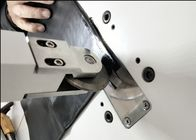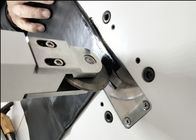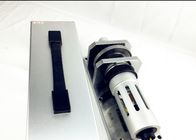
loading




| Quantity: | |
| Place of Origin | China |
|---|---|
| Brand Name | RPS-SONIC |
| Certification | CE |
| Model Number | RPS-S800 |
| Minimum Order Quantity | 1set |
| Price | negotiation |
| Packaging Details | FOAM AND CARTON |
| Delivery Time | 5days |
| Payment Terms | T/T, Western Union, MoneyGram, paypal |
| Supply Ability | 500 sets per month |
| Name | Ultrasonic Sealing Machine | Frequency | 35khz |
|---|---|---|---|
| Power | 800W | Horn Material | Rapid Steel,Titanium |
| Generator | Digital | Weight | 8.5Kg |
| High Light | ultrasonic sealing machine,ultrasonic seam welding equipment | ||
An ultrasonic rotary horn has tapered input sections for the conversion of axial acoustic energy into radial acoustic energy. The preferred rotary horn includes a first half having a first radial weld section and a first axial input section for receiving a first axial acoustic energy. The rotary horn further includes a second half coupled to the first half. The second half has a second radial weld section and a second axial input section for receiving a second axial acoustic energy. Each half has a coned section defined by an inner tapered surface and an outer tapered surface such that the halves convert a portion of the first and second axial acoustic energy into radial acoustic energy. Each inner tapered surface forms an inner angle with respect to an axis of the horn and each outer tapered surface forms an outer angle with respect to the axis.
An ultrasonic rotary horn comprising: a first radial weld section; and a first axial input section operatively coupled to the first radial weld section for receiving a first axial acoustic energy; said first axial input section having a first hollow coned section including an inner tapered surface forming an inner angle with respect to an axis of the horn and an outer tapered surface forming an outer angle with respect to the axis of the horn, wherein said inner angle is different from said outer angle such that the first axial input section and the first radial weld section convert a portion of the first axial acoustic energy into radial acoustic energy, the radial acoustic energy being in phase with the first axial acoustic energy.
It need be assembled on the ulltrasonic sewing machine, and drive by an other rotary horn.
Characteristics:
1. Seamming,trimming and embossing without glue, thread or other consumables
2. More faster and cost effective than traditional sewing machine and adhesive ways
3. Eliminates fraying or unraveling of bonded edges and seams
4. Multifunctional and thousands of designs available
5. Requires minimum training and maintenance
6. Super strong ultrasonic power meets the needs of different fabric thickness
RPS-SONIC specializes in manufacturing ultrasonic seam welding solutions for rotational systems.
Numerous seam soldering devices have been developed over the past years. From sonotrodes that can be installed in automated assembly lines, the Elmrt35 ultrasounds sewing machine up to customizations such as the PFW model devised for continuous welding of pleated filters.
There are two types of rotating modules for these operations: with either a side or central sonotrode resonating at a 35 kHz frequency and power varying from 600W to 1200W.
These horns can be made out of aluminium, treated with a special surface strengthening procedure, or titanium.
Our seam welding solutions are employed in binding synthetic textiles such as PVC, polyester, polypropylene, coated, filtering and technical fabrics.
| ITEM | DECRIPTION | |
| TYPE | 35FR1 | 35FR2
|
| Frequency | 35khz | 35khz |
| Max. power | 600W | 1000W |
| Rotary Welding Horn’s Width | 12mm | 12mm |
| Synchronizing Belt Matched | The Length is not more than730mm, the Width 12mm | |
| Max. Allowable Rotation Speed | 100 r/min. | |
| Install Bolt | M8, 4 pcs | |
| Generator | Digital generator can be adjusted the output amplitude from 50% to100%, continuously working | |
| Cable | Standard 5m Special length, please inform us. | |
APPLICATION:
Instead of needles, thread, glues or other adhesives, ultrasonic sewing equipment uses a patented rotary system, coupled with high-frequency vibrations, to bond synthetic or blended materials containing up to 40 percent natural fibers.
Resembling a traditional sewing machine, the ultrasonic sewing machine channels the ultrasonic vibrations between a horn and rotating wheel, producing a localized heat buildup which causes the synthetic fibers to soften and fuse. This creates a strong molecular bond that’s impervious to moisture. Explains Alleman, “the resulting barrier seams are sealed, secure, ultra-reliable and soft-to-the-touch without the safety issues caused by stitch holes, glue gaps, fraying or unraveling.”
| Name | Ultrasonic Sealing Machine | Frequency | 35khz |
|---|---|---|---|
| Power | 800W | Horn Material | Rapid Steel,Titanium |
| Generator | Digital | Weight | 8.5Kg |
| High Light | ultrasonic sealing machine,ultrasonic seam welding equipment | ||
An ultrasonic rotary horn has tapered input sections for the conversion of axial acoustic energy into radial acoustic energy. The preferred rotary horn includes a first half having a first radial weld section and a first axial input section for receiving a first axial acoustic energy. The rotary horn further includes a second half coupled to the first half. The second half has a second radial weld section and a second axial input section for receiving a second axial acoustic energy. Each half has a coned section defined by an inner tapered surface and an outer tapered surface such that the halves convert a portion of the first and second axial acoustic energy into radial acoustic energy. Each inner tapered surface forms an inner angle with respect to an axis of the horn and each outer tapered surface forms an outer angle with respect to the axis.
An ultrasonic rotary horn comprising: a first radial weld section; and a first axial input section operatively coupled to the first radial weld section for receiving a first axial acoustic energy; said first axial input section having a first hollow coned section including an inner tapered surface forming an inner angle with respect to an axis of the horn and an outer tapered surface forming an outer angle with respect to the axis of the horn, wherein said inner angle is different from said outer angle such that the first axial input section and the first radial weld section convert a portion of the first axial acoustic energy into radial acoustic energy, the radial acoustic energy being in phase with the first axial acoustic energy.
It need be assembled on the ulltrasonic sewing machine, and drive by an other rotary horn.
Characteristics:
1. Seamming,trimming and embossing without glue, thread or other consumables
2. More faster and cost effective than traditional sewing machine and adhesive ways
3. Eliminates fraying or unraveling of bonded edges and seams
4. Multifunctional and thousands of designs available
5. Requires minimum training and maintenance
6. Super strong ultrasonic power meets the needs of different fabric thickness
RPS-SONIC specializes in manufacturing ultrasonic seam welding solutions for rotational systems.
Numerous seam soldering devices have been developed over the past years. From sonotrodes that can be installed in automated assembly lines, the Elmrt35 ultrasounds sewing machine up to customizations such as the PFW model devised for continuous welding of pleated filters.
There are two types of rotating modules for these operations: with either a side or central sonotrode resonating at a 35 kHz frequency and power varying from 600W to 1200W.
These horns can be made out of aluminium, treated with a special surface strengthening procedure, or titanium.
Our seam welding solutions are employed in binding synthetic textiles such as PVC, polyester, polypropylene, coated, filtering and technical fabrics.
| ITEM | DECRIPTION | |
| TYPE | 35FR1 | 35FR2
|
| Frequency | 35khz | 35khz |
| Max. power | 600W | 1000W |
| Rotary Welding Horn’s Width | 12mm | 12mm |
| Synchronizing Belt Matched | The Length is not more than730mm, the Width 12mm | |
| Max. Allowable Rotation Speed | 100 r/min. | |
| Install Bolt | M8, 4 pcs | |
| Generator | Digital generator can be adjusted the output amplitude from 50% to100%, continuously working | |
| Cable | Standard 5m Special length, please inform us. | |
APPLICATION:
Instead of needles, thread, glues or other adhesives, ultrasonic sewing equipment uses a patented rotary system, coupled with high-frequency vibrations, to bond synthetic or blended materials containing up to 40 percent natural fibers.
Resembling a traditional sewing machine, the ultrasonic sewing machine channels the ultrasonic vibrations between a horn and rotating wheel, producing a localized heat buildup which causes the synthetic fibers to soften and fuse. This creates a strong molecular bond that’s impervious to moisture. Explains Alleman, “the resulting barrier seams are sealed, secure, ultra-reliable and soft-to-the-touch without the safety issues caused by stitch holes, glue gaps, fraying or unraveling.”








Ultrasonic Welding Equipment Ultrasonic Welding Transducer Ultrasonic Welding Converter Ultrasonic Liquid Processor Ultrasonic Cutting Equipment Ultrasonic Spray Nozzles Ultrasonic Power Supply Ultrasonic Soldering Equipment Ultrasonic Welding Horn Ultrasonic Assisted Machining Ultrasonic Testing Equipment
content is empty!